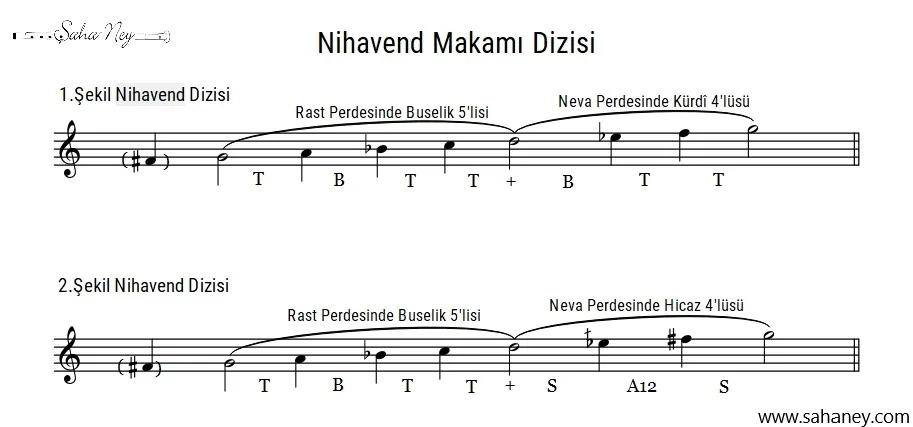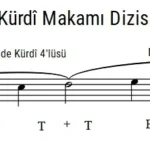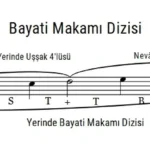In earlier times, within the tradition of naming Turkish music makams after cities or regions—such as Irak, Hicaz, Nişâbur (Nişâpur), or Tebriz—the city of Nihâvend in Iran also came to be known as the name of a makam. The present-day Nihâvend makam was formerly called nihâvend-i rûmî. This name was used to distinguish it from another makam called nihâvend-i kebîr, but over time the distinction was dropped and only the name nihâvend remained. The Nihâvend makam is obtained by transposing the scale of the Bûselik Makam onto the Râst fret. From the perspective of Western music, the Nihâvend makam corresponds to G minor.A scale with a Kürdî tetrachord on the dominant (güçlü) corresponds to the natural minor, while one with a Hicaz tetrachord corresponds to the harmonic minor.
Nihavend Ney Taksimi – Aka Gündüz Kutbay
It is the Râst pitch.
It is descending–ascending in character. Although the progression may sometimes begin ascending or sometimes descending, it soon returns to a predominantly ascending–descending form.
It is the transposition (şed) of the Bûselik makam scale on the Râst fret. Thus, it is formed by adding either a Kürdî tetrachord on the dominant Nevâ (D) or, as in the second form of the Bûselik scale, a Hicaz tetrachord to the Bûselik pentachord on the Râst fret.
The Nihâvend makam scale has the same sequence of notes as the G minor scale in Western music. A scale with a Kürdî tetrachord on the dominant corresponds to the natural minor, while one with a Hicaz tetrachord corresponds to the harmonic G minor.
The Nevâ (5th degree, D) note, where the Bûselik pentachord merges with the Kürdî or Hicaz tetrachord, is the dominant (güçlü) of the makam. A half pause (yarım karar) with either the Kürdî or Hicaz flavor is made on this note. However, especially at the beginning of the melody, the scale featuring the Kürdî flavor on Nevâ is more commonly preferred.
The Nihâvend makam is quite rich in hanging pauses (asma kararlar). Hanging pauses with the Çârgâh flavor are made on the 6th degree Nîm Hisâr fret (E flat), and with the Bûselik flavor on the 4th degree Çârgâh fret (G). However, to perform these two hanging pauses and flavors, the Nîm Şehnâz fret (A flat), which is foreign to the scale, must be used. Otherwise, these flavors do not occur. Essentially, the use of this fret also creates a distinct color within the makam.

Since the Nihâvend makam scale is the same as the G minor scale in Western music, it has a relation to B-flat major, which is the neighboring key of G minor. The hanging pauses with the Çârgâh flavor on the Kürdî fret in the Nihâvend makam are performed due to this closeness. Similarly, hanging pauses with the Kürdî flavor are also made on the Dügâh fret, which is the second degree of the same scale.

In some Nihâvend compositions, a small Uşşak passing note is observed on the Nevâ fret. Although this is not part of the makam’s fundamental structure, it serves as a beautiful ornament that adds color to the makam. To perform this passing note, the Nîm Hisâr fret is skipped and replaced by the Dik Hisâr fret. In certain Nihâvend pieces, usually during the opening phrase and sometimes later, there is a modulation to the Nev’eser makam. This is a natural modulation reflecting the Oriental flavor of the Nihâvend makam, which corresponds to either the natural minor or harmonic minor scale of G minor.

The small mücenneb flat is notated for Si (B) and Mi (E). Other necessary alterations are indicated within the piece itself.
They are Râst, Dügâh, Kürdî, Çârgâh, Nevâ, Nîm, Hisâr, Acem, and Gerdâniye. When there is a Hicaz on Nevâ, the Nevâv, Hisâr, Eviç, and Gerdâniye frets are used.
It is the Irak fret, located at the interval of a minor second (B-sharp F).
The Nihâvend makam can expand both above the high tonic (tîz durak) and below the tonic fret. In other words, the makam can develop through expansions from both the higher and lower registers.
- Expansion on the higher (tîz) side: The Kürdî tetrachord on the dominant Nevâ fret can be extended into a Kürdî scale on Nevâ by placing a Bûselik pentachord on the Gerdâniye fret.
If a scale with a Hicaz tetrachord on Nevâ is used, we can similarly extend the Hicaz tetrachord on the Nevâ note by placing a Bûselik pentachord on the Gerdâniye note, thus forming the Hümâyûn scale on Nevâ. In both cases, the situation remains unchanged, and a Bûselik pentachord is always placed on Gerdâniye. This Bûselik pentachord placed on the Gerdâniye note can also be considered the higher (tîz) symmetrical counterpart of the Bûselik pentachord on the tonic Râst note.
- Expansion on the higher (tîz) side: The Kürdî tetrachord on the dominant Nevâ fret can be extended into a Kürdî scale on Nevâ by placing a Bûselik pentachord on the Gerdâniye fret.

- Expansion on the lower (pest) side: It is done by placing a Hicaz tetrachord on the Yegâh note, which creates a Hümâyûn scale from Yegâh to Nevâ. Now, let's look at the expansions on both sides together:

This 15-tone scale is generally suitable for instrumental works because nearly every musical instrument has 15 tones. However, compositions written for the human voice should not exceed 11–12 tones. Therefore, in vocal works, if the melody descends deeply into the lower (pest) range, it should not rise too much into the higher (tîz) range; likewise, if the melody explores the higher (tîz) region extensively, it should not descend too much into the lower (pest) range. The most appropriate approach for vocal compositions is to use an average vocal range of about 11–12 tones. To put it more practically: if the expansion on the higher (tîz) side is used in vocal pieces, the expansion on the lower (pest) side should be avoided; or if the lower (pest) expansion is used, then the higher (tîz) expansion should not be favored.
The melody begins around the dominant (güçlü). If it starts ascending or descending, it quickly returns to the dominant. After wandering through the various flavors (çeşniler) that make up the scale, a half pause (yarım karar) is made on the dominant Nevâ note. Of course, necessary hanging pauses (asma kararlar) are indicated where appropriate. Finally, after further varied exploration and optionally traversing the expanded regions, a full pause (tam karar) with the Bûselik flavor is made on the Râst note, usually on the seventh degree (yedenli).






